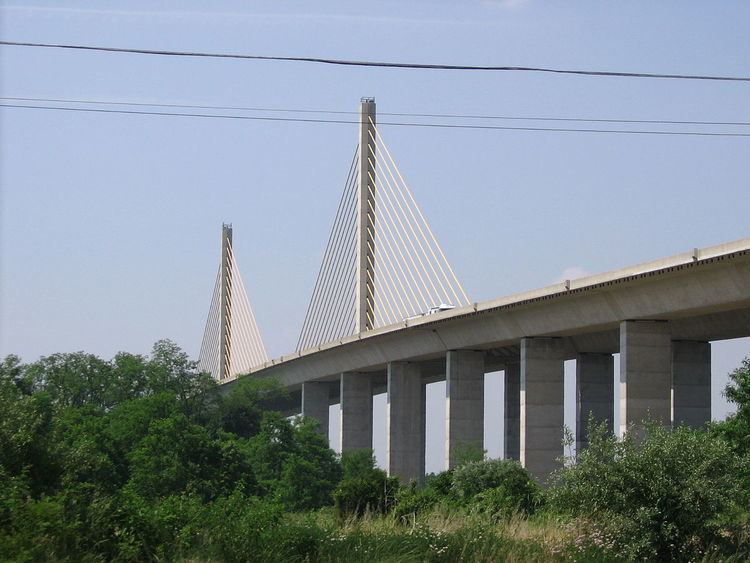Carries 6 lanes of DE 1 Other name(s) New St. Georges Bridge Construction started 1991 Total length 1,417 m Location Saint Georges, Delaware | Locale St. Georges, Delaware Address Middletown, DE 19709, USA Clearance below 30 m Opened 23 December 1995 Bridge type Cable-stayed bridge | |
 | ||
Crosses Chesapeake & Delaware Canal Official name Senator William V. Roth, Jr. Bridge Maintained by U.S. Army Corps of Engineers Similar St Georges Bridge, Cupola Park, Harbor of Refuge Light, Reedy Point Bridge, Chesapeake & Delaware | ||
The Chesapeake & Delaware Canal Bridge (officially the Senator William V. Roth, Jr. Bridge) is a concrete and steel cable-stayed bridge that spans the Chesapeake & Delaware Canal near St. Georges, Delaware. The bridge is located near a tolled section of Delaware Route 1 that runs parallel to the St. Georges Bridge carrying U.S. Highway 13. In November 2006, the bridge was named after U.S. Senator William V. Roth, Jr., who not only lent his name to the Roth IRA, but was instrumental in securing federal funding to build the bridge. It is owned and operated by the U.S. Army Corps of Engineers and does not carry a toll, despite the location of a nearby toll plaza.
Contents
History
The idea of the C & D Canal Bridge came about in the late 1980s when former Governor Michael N. Castle investigated a new canal crossing to replace the aging St. Georges Bridge. Originally, the plan was to use the four-lane bridge as part of the planned "Dover Extension" of the Delaware Turnpike, but local opposition to the plan forced Delaware officials to look at a new location. Although different plans were looked at, the final plan, using a concrete bridge was approved in 1989.
Shortly after construction began on the "Route 7 Relocation" the present-day Tybouts Corner-Delaware Turnpike section of Delaware Route 1, construction began on the bridge in 1992, with the excavation of the nearby site, located just one mile west of the corporate limit of St. Georges. The two halves were joined at the center in early 1994 and the bridge opened in December 9, 1995 when the Tybouts Corner-Biddles Corner section of Delaware Route 1 was completed.
After its opening, the Corps of Engineers rerouted U.S. Highway 13 onto the new bridge and for a few years, closed the old St. Georges Bridge, with the intent of demolishing it. After local opposition, the old St. Georges Bridge was rehabilitated with new lead-free paint, new roadway deck, and several joint and structural repairs that allows medium weight trucks, for local deliveries, to use the old crossing. A new exit for U.S. 13 and Lorewood Grove Road, which connects St. Georges with Summit was opened after the rehabilitation project was completed.
As a stipulation in keeping both bridges open, and in the case that the older St. Georges Bridge is in need of repair or replacement, no tolls are charged on the C & D Canal Bridge. The new exit for U.S. 13/Lorewood Grove Road serves as the "last chance" exit before the Biddle Corner toll plaza for Delaware Rt. 1.
Physical Description
The C & D Canal Bridge, the first cable-stayed bridge of its type in the Delaware Valley area (all previous Delaware River or C & D Canal bridges are either suspension, cantilever, or simple truss designs), is also the first pre-cast concrete bridge to be built in the United States. Modeled after that of the Sunshine Skyway Bridge in St. Petersburg, Florida, the bridge incorporates many features not found on the other canal bridges:
The bridge also incorporates a 3% climbing grade, a feature lacked on the nearby St. Georges Bridge. The bridge, built between 1991 and 1994, utilized pre-cast concrete segments that were made in Cape Charles, Virginia, and transported by barge until it reached the job site. Once at the site, the segments were fitted into place like that of a jigsaw puzzle.
